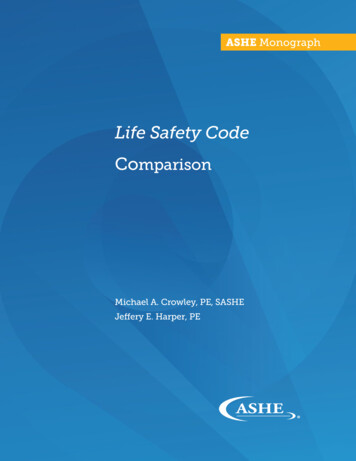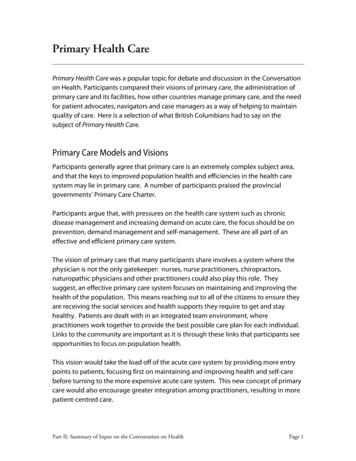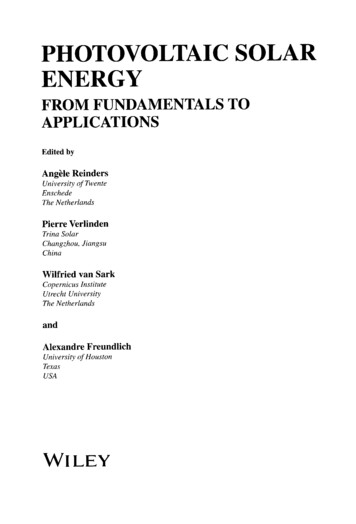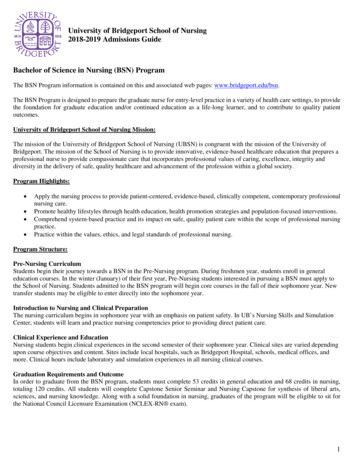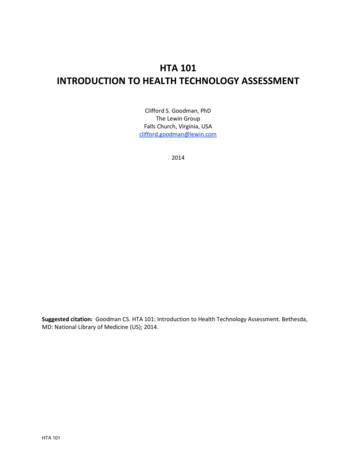
Transcription
HTA 101INTRODUCTION TO HEALTH TECHNOLOGY ASSESSMENTClifford S. Goodman, PhDThe Lewin GroupFalls Church, Virginia, USAclifford.goodman@lewin.com2014Suggested citation: Goodman CS. HTA 101: Introduction to Health Technology Assessment. Bethesda,MD: National Library of Medicine (US); 2014.HTA 101
TABLE OF CONTENTSACKNOWLEDGMENTS . ivABOUT THE AUTHOR. vI.INTRODUCTION . I-1A.Origins of Technology Assessment. I-2B.Early Health Technology Assessment. I-3References for Chapter I . I-5II.FUNDAMENTAL CONCEPTS . II-1A.Health Technology. II-1B.Health Technology Assessment. II-3C.Properties and Impacts Assessed . II-5D.Expertise for Conducting HTA . II-24E.Basic HTA Frameworks . II-25References for Chapter II . II-27III. PRIMARY DATA METHODS . III-1A.Primary Data Studies: Diverse Attributes. III-1B.Assessing the Quality of Primary Data Studies . III-4C.Instruments for Assessing Quality of Individual Studies . III-14D.Strengths and Limitations of RCTs. III-14E.Different Study Designs for Different Questions . III-21F.Complementary Methods for Internal and External Validity . III-23G.Evidence Hierarchies . III-24H.Alternative and Emerging Study Designs Relevant to HTA . III-27I.Collecting New Primary Data . III-30References for Chapter III . III-32HTA 101i
IV. INTEGRATIVE METHODS . IV-1A.Systematic Literature Reviews . IV-2B.Working with Best Evidence . IV-7C.Meta-Analysis . IV-8D.Guidelines for Reporting Primary and Secondary Research . IV-11E.Modeling . IV-12F.Assessing the Quality of a Body of Evidence . IV-16G.Consensus Development . IV-21References for Chapter IV . IV-23V.ECONOMIC ANALYSIS METHODS . V-1A.Main Types of Economic Analysis in HTA . V-1B.Key Attributes of Cost Analyses . V-3C.Cost-Effectiveness Plane . V-8D.Cost-Utility Analysis Using Cost per QALY . V-10E.Role of Budget Impact Analysis . V-14F.Collecting Cost Data in Clinical Studies . V-15References for Chapter V . V-16VI. DETERMINE TOPICS . VI-1A.Identify Candidate Topics . VI-1B.Setting Assessment Priorities . VI-4C.Specify the Assessment Problem . VI-7D.Reassessment and the Moving Target Problem. VI-10References for Chapter VI . VI-13VII. RETRIEVE EVIDENCE . VII-1A.Types of Sources. VII-1B.Grey Literature . VII-5C.Publication Bias . VII-6D.Help for Searchers . VII-7References for Chapter VII . VII-9HTA 101ii
VIII. DISSEMINATE FINDINGS AND RECOMMENDATIONS . VIII-1A.Competing for Attention . VIII-1B.Basic Dissemination Framework . VIII-3C.Dissemination Plan . VIII-5D.Managing Access . VIII-5References for Chapter VIII . VIII-6IX. MONITOR IMPACT OF HTA . IX-1A.Attributing Impact to HTA Reports . IX-2B.Factors Influencing Impact . IX-3References for Chapter IX . IX-5X.SELECTED ISSUES IN HTA . X-1A.Barriers to HTA . X-1B.Quality of Care and HTA . X-3C.Comparative Effectiveness Research and HTA. X-4D.Patient-Centered Outcomes Research and HTA . X-5E.Personalized Health Care and HTA . X-8F.Patient and Consumer Involvement in HTA . X-9G.Rapid HTA . X-12H.Decentralization of HTA . X-13I.Locus of Assessment: Make or Buy? . X-15J.Underused Technologies and HTA . X-16K.Managed Entry and HTA . X-20L.Innovation and HTA . X-21M. Managing Individual Bias and Conflict of Interest . X-22References for Chapter X . X-26Glossary . G-1HTA 101iii
ACKNOWLEDGMENTSHTA 101: Introduction to Health Technology Assessment is derived from an evolving set of seminars andother presentations that I have given on health technology assessment since the mid-1980s. This thirdversion follows two done in 1998 and 2004 at the request of the National Information Center on HealthServices Research and Health Care Technology (NICHSR) of the US National Library of Medicine (NLM).The core material for the 1998 version was assembled as a single document for a conference,Technology Assessment: A Tool for Technology Management and Improved Patient Outcomes, held inJanuary 1995 in Washington, DC. The conference was sponsored by the US Department of VeteransAffairs Health Services Research & Development Service and its Management Decision and ResearchCenter, and the Association for Health Services Research, since then incorporated into AcademyHealth.HTA 101 draws from the work of the many colleagues and thousands of authors whose publications arecited in the references. In particular, I acknowledge the influence of David Banta, Robert Brook, the lateThomas Chalmers, David Eddy, the late John Eisenberg, Egon Jonsson, and the late Fred Mosteller on myunderstanding of the field and appreciation for the importance of involving others in it. During her longtenure at NICHSR, Ione Auston contributed to this work directly as well as indirectly through her effortsto strengthen and encourage sharing and coordination of HTA information resources in the US andglobally. Additional thanks go to the hundreds of people from around the world who have attended andprovided feedback on the HTA 101 short courses I have given at annual meetings of Health TechnologyAssessment International (HTAi) and, before those, the International Society of Technology Assessmentin Health Care, since the 1990s.As were the earlier versions of this work, the updating, expansion, and preparation of HTA 101 fordistribution and viewing via the World Wide Web was funded by NICHSR, NLM. I wish to acknowledgethe expert guidance and support of Ione Auston, Catherine Selden, and Patricia Gallagher, the NICHSRproject officers for these efforts. Thanks go as well to Debbie Faulk for formatting this document.Clifford S. GoodmanThe Lewin GroupMay 2014HTA 101iv
ABOUT THE AUTHORClifford S. Goodman, PhD, is a Senior Vice President and Principal at The Lewin Group. He has 30 yearsof experience in such areas as health technology assessment (HTA), evidence-based health care,comparative effectiveness research, health economics, and studies pertaining to health care innovation,regulation, payment, and access. He directs studies and projects for an international range ofgovernment agencies; pharmaceutical, biotechnology, and medical device companies; health careprovider institutions; and professional, industry, and patient advocacy groups. His work on databases inHTA and health services research contributed to the development of the HealthSTAR (later incorporatedinto MEDLINE) and HSRProj databases of the National Library of Medicine. He has testified to the USCongress on issues pertaining to Medicare coverage of health care technology. Dr. Goodman served asChair (2009-12) of the Medicare Evidence Development & Coverage Advisory Committee (MEDCAC) forthe US Centers for Medicare and Medicaid Services. He served as President (2011-13) of theprofessional society, Health Technology Assessment International (HTAi), and is a Fellow of theAmerican Institute for Medical and Biological Engineering (AIMBE).Earlier in his career, as a National Research Council Fellow and later as director of the Council on HealthCare Technology, he managed and staffed a series of HTA projects at the Institute of Medicine of the USNational Academy of Sciences, including the landmark study, Assessing Medical Technologies.Subsequently, Dr. Goodman was a visiting researcher at the Swedish Council on Technology Assessmentin Health Care (SBU) in Stockholm. He did his undergraduate work at Cornell University, received amaster's degree from the Georgia Institute of Technology, and earned his doctorate from the WhartonSchool of the University of Pennsylvania.The Lewin Group (www.lewin.com) is a national health care and human services consulting firm based inFalls Church, Virginia, near Washington, DC. It has delivered objective analyses and strategic counsel topublic agencies, nonprofit organizations, industry associations and private companies across the UnitedStates for more than 40 years. The Lewin Group does not advocate for any policy, program or legislation.The Lewin Group is an Optum company. Optum is an analytics, technology and consulting services firm.Optum is a wholly-owned subsidiary of UnitedHealth Group, a diversified health and well-beingcompany. Neither Optum nor UnitedHealth Group or its subsidiaries review the work products of TheLewin Group. The Lewin Group operates with editorial independence and provides its clients with theexpert and impartial health care and human services policy research and consulting services.HTA 101v
I. INTRODUCTIONTechnological innovation has yielded truly remarkable advances in health care during the last fivedecades. In recent years, breakthroughs in a variety of areas have helped to improve health caredelivery and patient outcomes, including antivirals, anticlotting drugs, antidiabetic drugs,antihypertensive drugs, antirheumatic drugs, vaccines, pharmacogenomics and targeted cancertherapies, cardiac rhythm management, diagnostic imaging, minimally invasive surgery, jointreplacement, pain management, infection control, and health information technology.The proliferation of health care technology and its expanding uses have contributed to burgeoninghealth care costs, and the former has been cited as “culprit” for the latter. However, this relationship isvariable, complex, and evolving (Cutler 2001; Cutler 2011; Goyen 2009; Medicare Payment AdvisoryCommission 2001; Newhouse 1992; Smith 2000). In the US, the Congressional Budget Office concludedthat “roughly half of the increase in health care spending during the past several decades was associatedwith the expanded capabilities of medicine brought about by technological advances” (US CongressionalBudget Office 2008).Few patients or clinicians are willing to forego access to state-of-the-art health care technology. In thewealthier countries and those with growing economies, adoption and use of technology has beenstimulated by patient and physician incentives to seek any potential health benefit with limited regardto cost, and by third-party payment, provider competition, effective marketing of technologies, andconsumer awareness. Box I-1 shows some of the factors that influence demand for health technology.Box I-1. Factors That Reinforce the Market for Health Technology Advances in science and engineeringIntellectual property, especially patent protectionAging populationsIncreasing prevalence of chronic diseasesEmerging pathogens and other disease threatsThird-party payment, especially fee-for-service paymentFinancial incentives of technology companies, clinicians, hospitals, and othersPublic demand driven by direct-to-consumer advertising, mass media reports, social media, and consumerawareness and advocacyOff-label use of drugs, biologics, and devices“Cascade” effects of unnecessary tests, unexpected results, or patient or physician anxietyClinician specialty training at academic medical centersProvider competition to offer state-of-the-art technologyMalpractice avoidanceStrong or growing economiesIn this era of increasing cost pressures, restructuring of health care delivery and payment, andheightened consumer demand—yet continued inadequate access to care for many millions of people—technology remains the substance of health care. Culprit or not, technology can be managed in waysthat improve patient access and health outcomes, while continuing to encourage useful innovation. Thedevelopment, adoption, and diffusion of technology are increasingly influenced by a widening group ofpolicymakers in the health care sector. Health product makers, regulators, clinicians, patients, hospitalmanagers, payers, government leaders, and others increasingly demand well-founded information toHTA 101Introduction I-1
support decisions about whether or how to develop technology, to allow it on the market, to acquire it,to use it, to pay for its use, to ensure its appropriate use, and more. The growth and development ofhealth technology assessment (HTA) in government and the private sector reflect this demand.HTA methods are evolving and their applications are increasingly diverse. This document introducesfundamental aspects and issues of a dynamic field of inquiry. Broader participation of people withmultiple disciplines and different roles in health care is enriching the field. The heightened demand forHTA, in particular from the for-profit and not-for-profit private sectors as well as from governmentagencies, is pushing the field to evolve more systematic and transparent assessment processes andreporting to diverse users. The body of knowledge about HTA cannot be found in one place and is notstatic. Practitioners and users of HTA should not only monitor changes in the field, but haveconsiderable opportunities to contribute to its development.A. Origins of Technology AssessmentTechnology assessment (TA) arose in the mid-1960s from an appreciation of the critical role oftechnology in modern society and its potential for unintended, and sometimes harmful, consequences.Experience with the side effects of a multitude of chemical, industrial and agricultural processes andsuch services as transportation, health, and resource management contributed to this understanding.Early assessments concerned such topics as offshore oil drilling, pesticides, automobile pollution,nuclear power plants, supersonic airplanes, weather modification, and the artificial heart. TA wasconceived as a way to identify the desirable first-order, intended effects of technologies as well as thehigher-order, unintended social, economic and environmental effects (Banta 2009; Brooks and Bowers1970; Kunkle 1995; Margolis 2003).The term “technology assessment” was introduced in 1965 during deliberations of the Committee onScience and Astronautics of the US House of Representatives. Congressman Emilio Daddarioemphasized that the purpose of TA was to serve policymaking:[T]echnical information needed by policymakers is frequently not available, or not in the rightform. A policymaker cannot judge the merits or consequences of a technological programwithin a strictly technical context. He has to consider social, economic, and legal implicationsof any course of action (US Congress, House of Representatives 1967).Congress commissioned independent studies by the National Academy of Sciences, the NationalAcademy of Engineering (NAE), and the Legislative Reference Service of the Library of Congress thatsignificantly influenced the development and application of TA. These studies and further congressionalhearings led the National Science Foundation to establish a TA program and, in 1972, Congress toauthorize the congressional Office of Technology Assessment (OTA), which was founded in 1973,became operational in 1974, and established its health program in 1975.Many observers were concerned that TA would be a means by which government would impede thedevelopment and use of technology. However, this was not the intent of Congress or of the agenciesthat conducted the original TAs. In 1969, an NAE report to Congress emphasized that:Technology assessment would aid the Congress to become more effective in assuring thatbroad public as well as private interests are fully considered while enabling technology to makethe maximum contribution to our society's welfare (National Academy of Engineering 1969).HTA 101Introduction I-2
With somewhat different aims, private industry used TA to aid in competing in the marketplace, forunderstanding the future business environment, and for producing options for decision makers.TA methodology drew upon a variety of analytical, evaluative, and planning techniques. Among thesewere systems analysis, cost-benefit analysis, consensus development methods (e.g., Delphi method),engineering feasibility studies, clinical trials, market research, technological forecasting, and others. TApractitioners and policymakers recognized that TA is evolving, flexible, and should be tailored to the task(US Congress, Office of Technology Assessment 1977). Box I-2 shows various definitions of TA.Box I-2. Some Definitions of Technology Assessment[Technology assessment is] the systematic study of the effects on society, that may occur when a technology isintroduced, extended, or modified, with emphasis on the impacts that are unintended, indirect, or delayed(Coates 1976).Technology assessment (TA) is a category of policy studies, intended to provide decision makers withinformation about the possible impacts and consequences of a new technology or a significant change in an oldtechnology. It is concerned with both direct and indirect or secondary consequences, both benefits anddisbenefits, and with mapping the uncertainties involved in any government or private use or transfer of atechnology. TA provides decision makers with an ordered set of analyzed policy options, and an understandingof their implications for the economy, the environment, and the social, political, and legal processes andinstitutions of society (Coates 1992).Technology assessment ultimately comprises a systems approach to the management of technology reachingbeyond technology and industrial aspects into society and environmental domains. Initially, it deals withassessment of effects, consequences, and risks of a technology, but also is a forecasting function looking intothe projection of opportunities and skill development as an input into strategic planning. In this respect, it alsohas a component both for monitoring and scrutinizing information gathering. Ultimately, TA is a policy andconsensus building process as well (UN Branch for Science and Technology for Development 1991).Technology assessment is a form of policy research that examines short- and long-term social consequences(for example, societal, economic, ethical, legal) of the application of technology. The goal of technologyassessment is to provide policy-makers with information on policy alternatives (Banta 1993).Technology Assessment is a concept, which embraces different forms of policy analysis on the relationbetween science and technology on the one hand, and policy, society and the individual on the other hand.Technology Assessment typically includes policy analysis approaches such as foresight; economic analysis;systems analysis; strategic analysis etc. Technology Assessment has three dimensions: the cognitivedimension creating overview on knowledge, relevant to policy-making; the normative dimension establishing dialogue in order to support opinion making; the pragmatic dimension establish processes thathelp decisions to be made. And TA has three objects: the issue or technology; the social aspects; the policyaspects (European Parliamentary Technology Assessment 2013).B. Early Health Technology AssessmentHealth technologies had been studied for safety, effectiveness, cost, and other concerns long before theadvent of HTA. Development of TA as a systematic inquiry in the 1960s and 1970s coincided with theintroduction of some health technologies that prompted widespread public interest in matters thattranscended their immediate health effects. Health care technologies were among the topics of early TAs.Multiphasic health screening was one of three topics of “experimental” TAs conducted by the NAE at therequest of Congress (National Academy of Engineering 1969). In response to a request by the NationalScience Foundation to further develop the TA concept in the area of biomedical technologies, the NationalResearch Council conducted TAs on in vitro fertilization, predetermination of the sex of children,HTA 101Introduction I-3
retardation of aging, and modifying human behavior by neurosurgical, electrical or pharmaceutical means(National Research Council 1975). The OTA issued a report on drug bioequivalence in 1974 (Drugbioequivalence 1974), and the OTA Health Program issued its first formal report in 1976.Since its early years, HTA has been fueled in part by emergence and diffusion of technologies that haveevoked social, ethical, legal, and political concerns. Among these technologies are contraceptives, organtransplantation, artificial organs, life-sustaining technologies for critically or terminally ill patients, and,more recently, genetic testing, genetic therapy, ultrasonography for fetal sex selection, and stem cellresearch. These technologies have challenged certain societal institutions, codes, and other normsregarding fundamental aspects of human life such as parenthood, heredity, birth, bodily sovereignty,freedom and control of human behavior, and death (National Research Council 1975).Despite the comprehensive approach originally intended for TA, its practitioners recognized early onthat “partial TAs” may be preferable in circumstances where selected impacts are of particular interestor where necessitated by resource constraints (US Congress, Office of Technology Assessment 1977). Inpractice, relatively few TAs have encompassed the full range of possible technological impacts; mostfocus on certain sets of impacts or concerns. Indeed, the scope of HTA reports has been diversified inrecent years by the use of “horizon scanning” and the demand for “rapid HTAs,” which are describedlater in this document.Various definitions of HTA are shown in Box I-3.Box I-3. Some Definitions of Health Technology AssessmentWe shall use the term assessment of a medical technology to denote any process of examining and reportingproperties of a medical technology used in health care, such as safety, efficacy, feasibility, and indications foruse, cost, and cost-effectiveness, as well as social, economic, and ethical consequences, whether intended orunintended (Institute of Medicine 1985).Health technology assessment . is a structured analysis of a health technology, a set of related technologies,or a technology-related issue that is performed for the purpose of providing input to a policy decision (USCongress, Office of Technology Assessment 1994).Health Technology Assessment asks important questions about these technologies [drugs, devices, procedures,settings of care, screening] such as: When is counselling better than drug treatment for depression? What isthe best operation for aortic aneurysms? Should we screen for human papilloma virus when
HTA 101: Introduction to Health Technology Assessment is derived from an evolving set of seminars and other presentations that I have given on health technology assessment since the mid-1980s. This third version follows two done in 1998 and 2004 at the request of t




